Kelly, the Sassy Dolphin
What can one brash dolphin teach us about personality?
Article body copy
The Atlantis resort in the Bahamas is an imposing place. It sits just north of downtown Nassau, the capital of the Bahamas, on its own little stretch of sand dubbed Paradise Island. The main building has two high towers, over 20 stories each, connected at the top by a broad, arched walkway that’s dotted with giant statues of marlin and other sea creatures, both mythical and real. The main entrance is marked by a huge statue of golden Pegasi arranged to look like they are in mid-flight, suspended in the air above a series of fountains. To check into the hotel, guests walk past the gilded Pegasus launch pad and over a bridge that’s flanked by gigantic nautilus-shell-shaped fountains that pour into a marina full of private yachts. Ted Turner, the vice president of the resort’s Dolphin Cay, is giving me a tour, and he lists off the guests who have stayed recently: P. Diddy, the Chicago Blackhawks, Harvey Weinstein. “Many, many famous and rich people come through here,” Turner says. The entire hotel is coral pink.
Atlantis sprawls over 692,000 square meters (slightly bigger than Washington, DC’s National Mall) and features, among other things, a 2,800-square-meter marina, a nightclub, thousands of rooms, a casino, a 75-million-liter water park, and 50,000 animals from over 250 marine species, including more than 100 sharks and 42 bottlenose dolphins.
I’m at Atlantis on a warm Monday in June to see one of those dolphins, a 44-year-old female named Kelly. When I arrive at Dolphin Cay, the sun is finally banishing the last of some storm clouds, and Kelly is across the far side of the pool, doing what’s called a “shallow water interaction” with guests. From ground level, Dolphin Cay looks like one big space. But beneath the water, there are gates and pens—keeping the dolphins separated from the guests and one another. When it’s their time to shine, a set of dolphins is released into the large area that leads up to the beach. The guests, all in matching Atlantis wetsuits provided for the occasion, stand in about a meter of water while Kelly and a handful of other dolphins, swimming out in deeper water past a drop-off, entertain them with tricks. As I walk to the edge of the pool, a crowd starts chanting “Kelly! Kelly! Kelly!” Linda Hammerton, the director of marine mammal operations at Dolphin Cay, laughs. “There goes Kelly, about to show off.” On cue, Kelly leaps out of the water in a graceful arc, and the crowd goes wild. She’s still an acrobat, despite her advanced age—bottlenose dolphins in the wild only live 15 to 20 years. “She’s my inspiration because everybody thinks at 44 you’re kinda over the hill—no you’re not! Kelly’s great,” Hammerton says.
The honeycomb-shaped features are Dolphin Cay, where Kelly and her cohort cavort for audiences at the Atlantis resort in the Bahamas. Video by VideoBlocks
I already know Kelly is great because I’ve spent the past several months in a deep, winding rabbit hole about her life. I’ve tracked her from the permit that allowed for her capture from the wild, to a brief stint in an Oklahoma zoo, to her harrowing escape from Hurricane Katrina, to the legal battle that followed, to the long flight from Philadelphia International Airport to Paradise Island in Atlantis. Along the way, I’ve met people who still remember Kelly a decade or more after meeting her and can spend all day telling stories of her tricks and antics. By now, I feel like I know Kelly like I know a distant relative. I can pick her out of photographs, tell people what she’s like, what she hates and loves, her quirks and tricks. But does Kelly the dolphin truly have a distinct personality? Or is every story I’ve heard about her a product of anthropomorphism and wishful thinking? This question divides even the people who work with and study dolphins every day. The science on whether dolphins have personalities is still murky at best, but Kelly herself might help researchers find their way through.
Kelly was captured in June 1978, netted in the warm waters off Florida when she was four or five years old. After being captured, she lived and performed at Marine Life Oceanarium in Gulfport, Mississippi, for over 20 years, save for a brief stint in the 1980s when she was rented out to the Oklahoma City Zoo. In Oklahoma, already a bit of a trickster, Kelly surprised her caretakers with an early April Fool’s Day prank: on March 20, 1988, at 4:20 p.m., she gave birth to a one-meter-long, 20-kilogram daughter. The trick wasn’t the time or size of her baby, it was that her keepers had no idea she was pregnant in the first place.
Her Oklahoma days were short though, and soon Kelly returned to Gulfport, where she entertained crowds daily—leaping out of the water, giving high fives, tossing balls back and forth with visitors. Of course, this kind of captive dolphin show is not beloved by everyone. Like all facilities that house captive dolphins, Marine Life was also the focus of activists who believe that housing marine mammals in small enclosures and asking them to perform for humans is cruel. Perhaps the one saving grace of keeping marine mammals captive is that we’ve learned so much from them, we’re beginning to ask questions about their inner lives and rethink how we treat them in the first place.

Kelly’s first home was Marine Life Oceanarium in Gulfport, Mississippi, where crowds and trainers alike were fascinated by her antics. Photo courtesy of Tim Hoffland
In Gulfport, a city just an hour northeast of New Orleans, Kelly gained a reputation as the show-off. Tim Hoffland joined Marine Life in 1991 as the director of training and live animal rescue and spent the next 15 years working with Kelly and her friends under the facility’s iconic blue metal roof. “She was very smart, even compared to the other ones,” Hoffland says. “When you’re training a new behavior, it’s like the light bulb goes on and they understand exactly what you want them to do.” Kelly was always one of the first to master a new behavior or trick—leaping 4.5 meters out of the water to touch a ball strung from the top of the stadium or doing a backflip. And not only did she learn quickly, she innovated too.
In a lot of enclosures like Marine Life, dolphins are trained to retrieve trash or stray objects in their pools in return for fish. “People are careless, they drop everything in the pool,” Hoffland tells me. “Batteries, cameras, pacifiers. So these guys were really good, and they would find anything.” Some days, he would walk by the pool and Kelly would be waiting patiently with some piece of something in her mouth—a flip-flop, a paper program, a plastic bag—ready to exchange her find for a tasty fish reward.
Eventually though, Kelly realized something. No matter how big the piece of trash she brought to her trainers, she always got the same amount of fish. Big trash, small trash, they all seemed equally valuable. So she did what any enterprising, crafty creature might: she gamed the system. Whenever she found trash and a trainer wasn’t around to reward her for it, she started stashing her finds, hiding garbage beneath a rock in the enclosure and bringing small pieces to the trainers whenever she saw them, maximizing her rewards by earning them more often with less work.

Kelly never ceased to amaze Marine Life trainer Tim Hoffland with her abilities, such as grabbing a 10-centimeter-long fish from his mouth after jumping close to five meters in the air. Photo courtesy of Tim Hoffland
It took the team at Marine Life a while to figure out exactly what Kelly was up to, but they knew something was off. Unlike the rest of the dolphins who would scope out the pool for bits to retrieve, Kelly often went straight for the bottom of the pool. “Like she knew exactly where they were,” Hoffland says. Eventually, the Marine Life team decided it was time to replace some of the glass on the side of the pool. It was only then that they found Kelly’s stash. “We had to completely drain the pool and that’s when we found it, under the rocks, there’s a pile of garbage there that she stashed.”
Anecdotes like this are impressive because they seem to suggest that these animals have a variety of high-level cognitive processes going on. Kelly figured out not just planning and delayed gratification—putting off a reward now to get more reward later—but she also understood enough to suspect that she should hide this strategy from her trainers and fellow dolphins. The fact that Kelly was the only dolphin to figure this out, and the fact that her trainers weren’t surprised in the slightest that she was the only one to figure it out, made Kelly seem not just smarter than her pool mates, but craftier and more cunning. And soon, all of Kelly’s traits would be put to the ultimate test.
On August 23, 2005, a storm started brewing in the warm waters southeast of the Bahamas. Two days later, it made landfall in Florida. After sliding over Florida, the storm hit the warm waters of the Gulf of Mexico and grew into a mighty hurricane named Katrina that slammed into southeast Louisiana on August 29. What happened next you probably remember: complete devastation.
Marine Life, situated right on the water in Gulfport, was not spared. There was no time to evacuate all the dolphins before the storm hit. Hoffland and his team trucked six dolphins to hotel swimming pools just seven kilometers north along Highway 49. But the other eight would have to stay at Marine Life, in the 2,271,247-liter, six-meter-high main tank, and ride out the storm. Kelly was one of those eight dolphins, along with her six-year-old son, Noah. (Her other son, Brewer, was relocated to a swimming pool.) When the staff of Marine Life left the aquarium on the 29th to hunker down in their own homes, they simply hoped for the best.
The best did not happen. Like so much else in the Gulf, Marine Life was completely ravaged by Katrina. The aquarium’s iconic metal roof was sheared clean off. Metal beams split and stretched and scattered across the entire footprint. The concrete amphitheater seating that surrounded the main tank was torn apart and piled up on itself, entire rows of seats flung from the bottom to the top of the theater. From the air, the facility looked as if someone had taken teal Silly String and sprayed it across the property, but instead of foam, the teal strings were the metal beams twisted around in the wind and surge. Marine Life staff could barely even get to the site (one had to use an ATV), as the roads were covered in debris from houses, boats, cars, and everything in between.
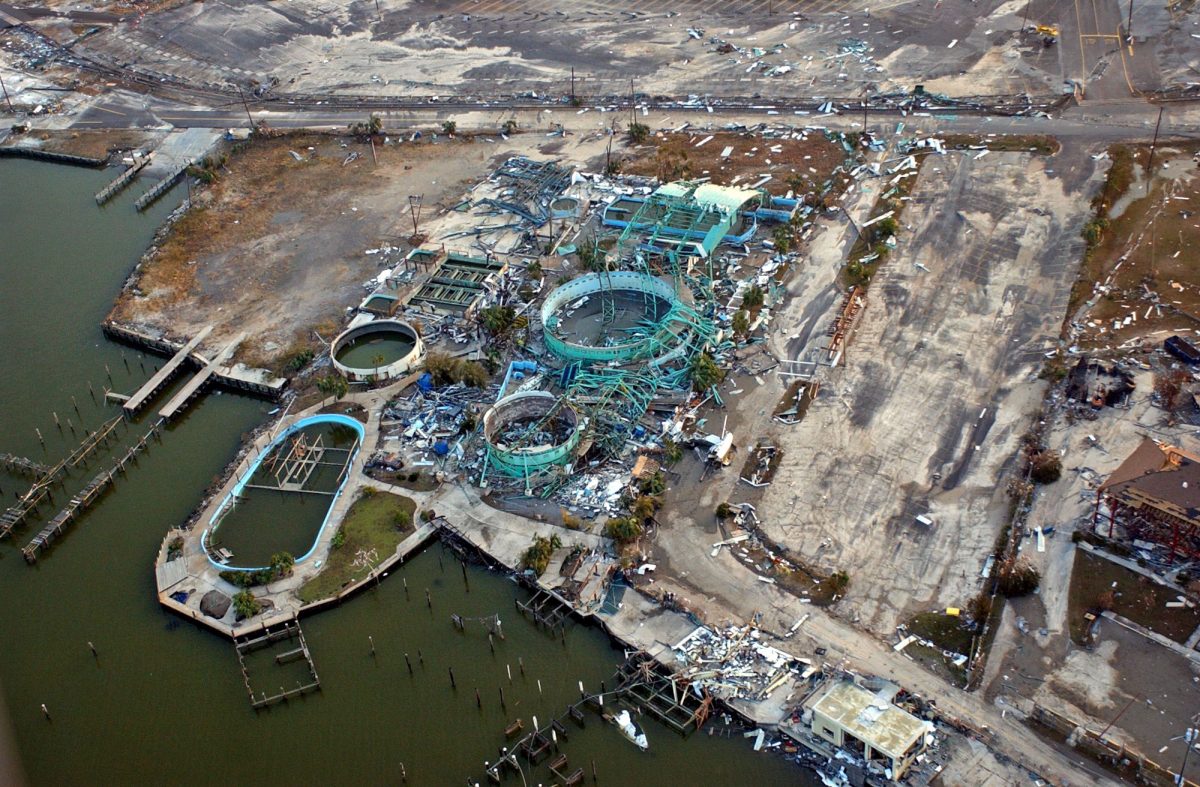
Hurricane Katrina devastated Marine Life, a marine park in Mississippi. Photo by David Purdy/KRT/Newscom
As staff approached the huge main tank where they had left the dolphins, they held their breath, hoping to see little heads pop up out of the water. The concrete ring of the tank itself appeared to have held up, but when they got closer, it became clear that the nightmare was only beginning. “There were no animals in the park at all,” Hoffland says, “which meant they were out there somewhere.” And he was going to try to find them.
The Gulf of Mexico post-Katrina was its own unique nightmare zone. The hurricane had broken and washed out to sea entire towns and cities, and their remains were floating in the water off the coast. The surge had pulled sewage, food, and bodies into the water, creating a gruesome soup. Sharks had closed in, drawn to the chicken that had spilled from cargo containers torn open in the storm. If the dolphins were still alive somehow, and still in the area, they were in danger of getting sick or injured. But the water was dangerous to traverse, and as much as the team wanted to get out there in boats as soon as possible, they had to wait for permission from the US Coast Guard.
Twelve days after Katrina hit Gulfport, Hoffland and his team were finally allowed into the Gulf to look for the dolphins. One group took off in a helicopter, the other went out on a boat. The helicopter team flew eight kilometers from the helipad out to the coast, over the wreckage of Marine Life, past the port authority cargo berths, and out over the Gulf, scanning the sea for any sign of dolphins. After flying above the water for less than a kilometer, shocking even the most hopeful members of the search party, they found them. All eight dolphins, alive and still together, just about 900 meters from where their pool stood.
From the boat, Hoffland called to his dolphins. “I got up there and I double blew my whistle, which means, ‘Stop what you’re doing come to station,’ and one of them popped up and then pop, pop, pop—all eight of them. They were right there.” Hoffland couldn’t believe it.
Finding the animals was only the beginning. Now, the team had to figure out how to get them out of the water and back into captivity—and it wouldn’t be easy. After living in captivity, the dolphins were too familiar with human tools—too net savvy to try to bring them in that way. Instead, Hoffland and his team came up with another plan: they would train the dolphins to offer themselves up for capture.
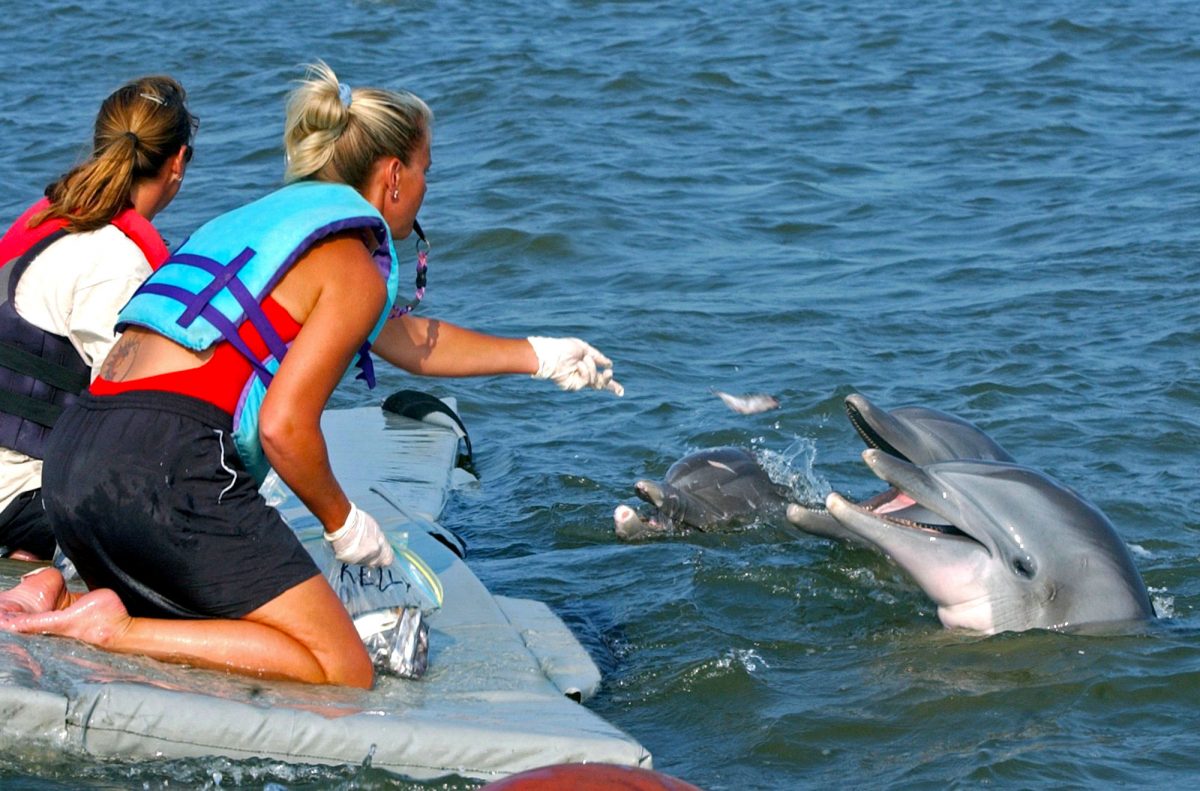
After Hurricane Katrina smashed into the Gulf Coast, trainers searched for the dolphins they left behind at Marine Life. All eight were found, less than a kilometer from their coastal pool. Photo by Tim Isbell/KRT/Newscom
Using a couple of gray floating mats chained together and anchored to the seafloor, the rescuers created a training platform. Four times a day, they went out to the mats and taught the dolphins a new behavior: beaching themselves onto the mats on command. The trick was a familiar one—the dolphins were already trained to beach themselves onto the deck of the Marine Life theater. Hoffland and the other trainers simply had to teach them the same thing, but in a new place.
As usual, Kelly learned quickly. And despite all the chaos of the past week that had both the dolphins and the crew exhausted, it worked. One by one, all eight dolphins learned the trick and started beaching themselves reliably onto the mats. Over the course of about a week (including several harrowing days when three of the dolphins disappeared only to be found 25 kilometers away), all eight dolphins offered themselves up, were wrapped up into special slings, and relocated to a navy base in Gulfport, where temporary containers had been set up for them.
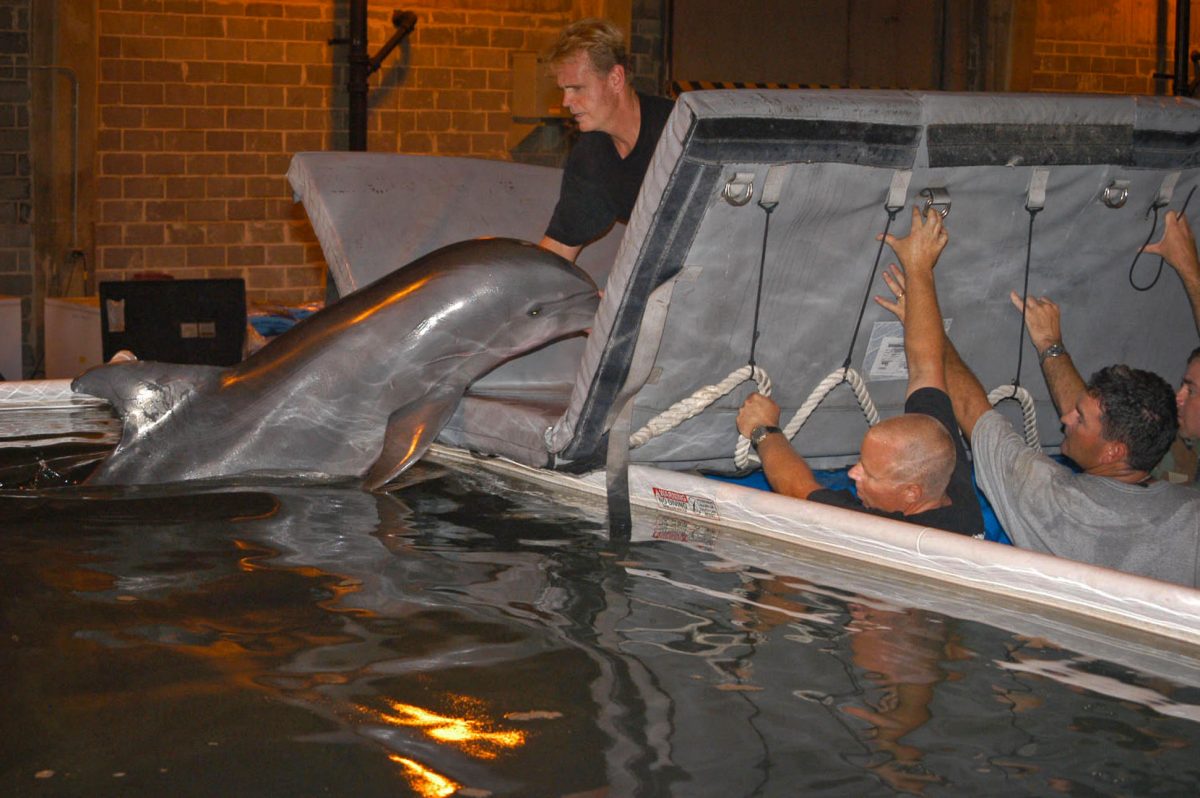
Kelly and seven other dolphins, swept out to sea when Hurricane Katrina hit their home in Gulfport, were caught and transferred to temporary saltwater pools as they awaited transportation to their next home in the Bahamas. Photo by PJF Military Collection/Alamy Stock Photo
How had these dolphins survived and stayed together? Hoffland thinks it was thanks to Kelly and her pod-mate Jill. Researchers who later reviewed the accounts of the recapture, noted that Kelly and Jill, ever the leaders, constantly positioned themselves four or five meters behind the others, watching for sharks and any other dangers. “We knew from past experiences that Kelly was a leader,” wrote late dolphin researcher Stan Kuczaj in a paper about the rescue. “She would always be the one to lead the other animals in perceived dangerous situations.” Kelly likely kept the younger dolphins in line and kept the group together. In fact, Kelly’s capture and removal from the group had prompted the remaining three animals to bolt, forcing the rescue team to scramble to relocate them.
Throughout the rescue mission, local news hailed the dolphins as a symbol of light in a time of extreme darkness in the Gulf. They had stuck together, supported each other, and survived. The dolphins were turned into proxies for the recovery efforts in the region. But while the dolphins were safe, they were still homeless. Marine Life was destroyed. What followed was a legal battle over the future of the dolphins. Marine Life was run by two men, president and CEO Moby Solangi and owner Don Jacobs. Solangi wanted to rebuild and keep the dolphins. Jacobs didn’t. (Solangi didn’t respond to a request to comment, and Jacobs died in 2011.)
The ensuing argument was ugly. Solangi filed an injunction to block the sale of the dolphins. Jacobs then fired Solangi from his position as president of Marine Life and pushed ahead with the sale. Ultimately, a Mississippi state judge ruled that the dolphins could be sold to Atlantis. Solangi and Jacobs settled their other disputes out of court with undisclosed terms, and on January 5, 2006, the dolphins were loaded into trucks and driven up to Philadelphia, where they boarded a plane bound for Nassau. Kelly’s berth was in the middle, over the left wing. If she could have looked out a window, she would have seen Gulfport receding into the distance and the blue water of the Bahamas (ironically, the exact place where Hurricane Katrina was born) coming into view.
Ted Turner, the vice president of Dolphin Cay, shares the story of how Kelly and her seven companions survived a hurricane and settled into their new home in the Bahamas. Video by Atlantis
Tim Hoffland hasn’t seen Kelly since she boarded that flight. I meet him at the Ocean Adventures Marine Park, a brightly colored and brand-new facility in Gulfport. It’s May, and the air is warm and moist. The US $15-million, 3,000-square-meter facility is 15 kilometers northeast of where Marine Life once stood, but the premise is the same. Ocean Adventures opened to the public in late March. The signs for the bathroom are still pieces of paper, taped to the glass doors. Hoffland is working with eight new dolphins, and the trainers coach the animals while we sit in the facility’s amphitheater, intermittently interrupted by dolphin chatter.
Even though he hasn’t seen her in over 10 years, Hoffland says he could pick Kelly out of a tank immediately. “She looked different than every other dolphin we had. She had a really light color to her, a very marbled head, very light shades of gray. She was very pretty.” Then I ask Hoffland if I should pass on a message to Kelly when I see her, and he pauses. “Tell her I miss her,” he says. When I ask if he’s ever thought about visiting her down in the Bahamas, he shakes his head no. He’s been busy, he says, but there’s another reason too. “I don’t want to have to say goodbye to her twice.”
At Atlantis, the trainers (or behaviorists, as Atlantis calls them) who work with Kelly each have a story about her. “She has one of the strangest little tongue waves that she does,” Hammerton says. “She’ll swim past you and just look up and like …” Hammerton cocks her head to the side and darts her tongue out of the side of her mouth like she’s imitating a gecko. “It’s weird because it’s the slickest little …” she does the motion again, “and I don’t know if I should report this to HR, I don’t quite know how to feel about this.” She laughs.
Charles Jones, one of the behaviorists at Atlantis, says if you’re not on your game, Kelly will take every inch she can get. “Sometimes she’ll figure ways to modify the behaviorist’s behavior,” he says.
Jones calls Kelly and her Katrina cohort his Destiny’s Child girls. “They’re survivors, they’re better than Destiny’s Child.”
Hammerton compares Kelly’s sassiness to an older woman. “She’s my Betty White.”
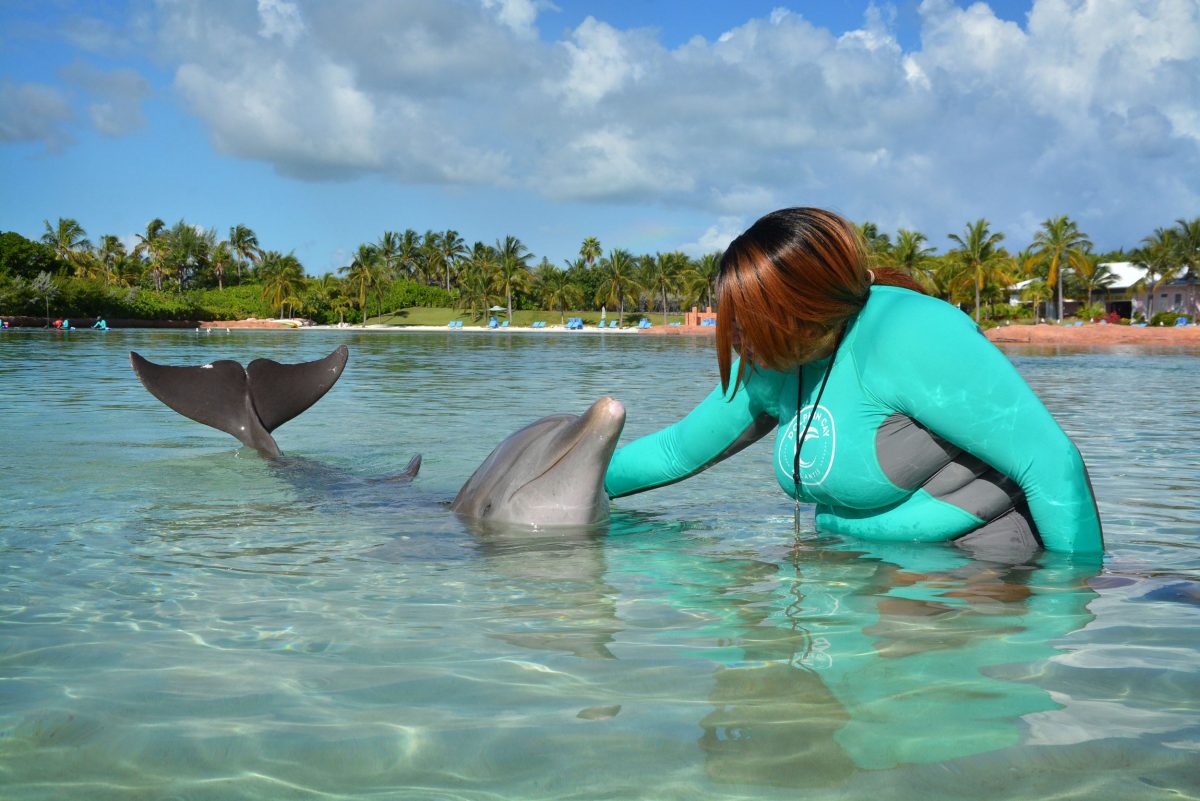
Linda Hammerton, an animal behaviorist at Atlantis, admires Kelly and what we humans might call her chutzpah. Photo courtesy of Atlantis
But not everybody describes Kelly in such human ways. Turner, the vice president of Dolphin Cay, is quick to point out that nearly everything I’ve written in this article so far highlights the dangers of anthropomorphism. By describing dolphins as tricksters, comparing them to television stars, and guessing at what they might be thinking, we impose our own human ideas about behavior onto other animals. And Turner hates anthropomorphism. Each time I ask him a question about Kelly’s personality, I get a gentle rejection. If Kelly does something, it’s because the behavior was reinforced. If she doesn’t, it’s because the behavior was not properly reinforced. It’s that simple, he says. Turner explains that he’s an animal behaviorist, before launching into another explanation of operant conditioning, a term coined by the inventor of the Skinner Box, psychologist B. F. Skinner whose research became a 1950s meme. Every question about an animal’s personality, Turner answers by talking about operant conditioning. What I describe as an indicator of personality, he says is simply a call and response. “It’s a manifestation of that reinforcement history and that conditioning process.”
It turns out that this is a heated debate in animal psychology: do animals even have personality to begin with? For centuries, scientists refused to use the term to describe animal behaviors. The word itself indicates the reason: you can’t spell personality without the word person. Instead, researchers talked about temperament and behavioral syndromes and reward systems.
But in the past 15 years, more and more scientists have started entertaining the idea that animals might indeed have their own distinct and stable personalities. “It makes evolutionary sense,” says Lauren Highfill, who’s written several papers on animal personalities. “You wouldn’t really want to have all dolphins in a social group behave in exactly the same way.” You need a bold one, for example, who’s willing to go check things out and give the all-clear. But a group full of fearless types, swimming right into shark-infested waters without a care in the world, would be an evolutionary disadvantage. “Just like with humans, it’s nice that we have different personalities,” Highfill says.
And she has evidence to back up her claims. In one study, Highfill compared personality ratings by trainers before and after dolphins went through a big life change to see if the dolphins got the same scores. Without distinct and stable personalities, you’d expect that between one scoring session and another, the animals would wind up with different ratings. But instead, Highfill found that the trainers who scored each dolphin on traits, such as openness, conscientiousness, extroversion, agreeableness, and neuroticism rated each dolphin consistently across time and space. And here’s the big reveal: the dolphins in Highfill’s study were Kelly and her pod. The big life change was Hurricane Katrina and their subsequent relocation to the Bahamas. Highfill had worked with the dolphins in Gulfport and had the trainers at Marine Life score the dolphins on those same traits before Katrina hit. Once they got settled at Atlantis, she asked the new caretakers to repeat the survey to see what happened.
There are other studies suggesting that Kelly and her cohort have distinct differences. In another paper, researchers documented the different mothering styles of seven dolphins including Kelly. That study found that Kelly had a more hands-off parenting style than the other dolphins—she was less likely to correct her offspring and herd them, and she spent less time with her offspring. Other mothers were far more doting and stuck by their calves constantly—helicopter parents, to anthropomorphize even further.
At the Atlantis resort in the Bahamas, dolphins—including those rescued from the Gulf after Hurricane Katrina—charm visitors at Dolphin Cay. Video by VideoBlocks
But not everybody who studies dolphin behavior is comfortable committing to the idea that dolphins have personalities. Well-controlled studies on dolphin personality are still few and far between, says Holli Eskelinen, the assistant director of research at Dolphins Plus Marine Mammal Responder in Key Largo, Florida, who has collaborated with Highfill on dolphin personality studies. Eskelinen’s work has shown that some of these behaviors—like the ones Highfill scored Kelly and her cohort on before and after Katrina—are inconsistent across different situations. Some dolphins, for example, show different “personalities” when they’re interacting with people than when they’re interacting with other dolphins.
The problem with much of the work on dolphin personality, Eskelinen says, is that it’s too anthropomorphic—it assumes that the same personality traits we see in humans might show up in dolphins and that we can test for those traits in the same way we test humans. Even the terms they’re testing for—openness, conscientiousness, extroversion, agreeableness, and neuroticism—are human ones. But dolphins live in an entirely different physical world from us. “When you study primates, they’re anatomically so similar to us, Eskelinen says. They’re also a terrestrial species. Dolphins, anatomically, they’re completely different. Their eyes are where our ears are.” Eskelinen finds herself somewhere between Turner and Highfill, not fully convinced that dolphins have personalities in the exact same way people do, but also not willing to go full B. F. Skinner.
But how can we possibly avoid confounding these studies? We are, after all, human beings, and really only know how to engage with the world as humans. The reason the public wants to know how smart dolphins are is because they want to know how to relate to them—as humans. And that’s not just limited to the public either. “I work at the university, even the most research-minded person, they want to know how smart they are. Are they as smart as my dog, my three-year-old child?” Eskelinen says. Our motivations are as fallible as our methods, and that corruption bleeds into the research. She thinks that eventually, as the research gets more developed, we’ll come up with new terms to more accurately describe the individual differences between individual dolphins.
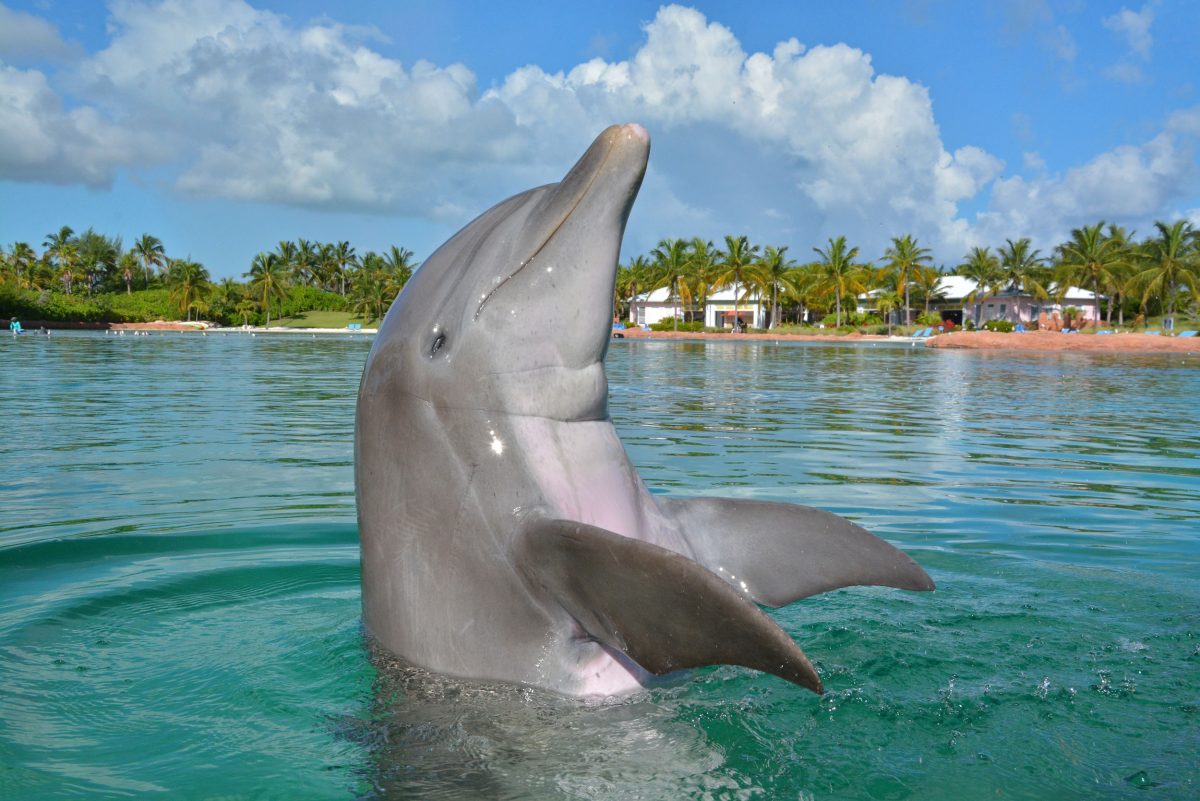
Kelly was one of eight dolphins lost from a marine park in Gulfport, Mississippi, when Hurricane Katrina devastated the area in 2005. Photo courtesy of Atlantis
Eskelinen admits that even she’s not immune to wanting dolphins to be more humanlike than they might actually be. One of the dolphins living at Atlantis, a male named Makai, she raised from birth at Dolphins Plus. “I wanted him to remember me so bad on my first visit down there,” she says, “even though you’re a research scientist you want that almost … aha moment to occur.” And of course she would, it would almost be heartless not to. So did he? Eskelinen couldn’t say. “I am not certain if he recognized me, but I was able to sit with him for a bit with his new caretakers,” she tells me. “He remembered some of his old hand signals and was attentive.” In the end, she describes it as “all just anecdotal fun.”
Turner sees most of this as silly wishful thinking. Everything I described as an indicator of personality, Turner reiterates is simply a call and response. He thinks the same about you, too, by the way. I ask him whether he applies this kind of analysis to the humans in his life, and he confirms that indeed he does. “The principles are all the same, whether you’re talking of a pigeon or a lowland gorilla or a human being or a PhD,” he says. Turner does at least recognize that this kind of behavior analysis does not win him friends, dolphin or human. “You can’t get into those kinds of discussions with people because they’re going to be like, ‘You’re boring and my feet work.’”
At Atlantis, I sit at the edge of the pool and watch Kelly perform for guests for a few hours. When her visitor interaction time is up for the day, she swims over to me, probably wondering if I have any fish to give her. When no one is looking, I lean down toward the water and feel a strange need to whisper what I am about to say. “Hi, Kelly, Tim Hoffland says he misses you,” I say. She doesn’t respond, in fact, she probably doesn’t even hear me since dolphins hear in a different frequency than humans speak. The whole thing feels very silly. But I’m still glad I did it.

